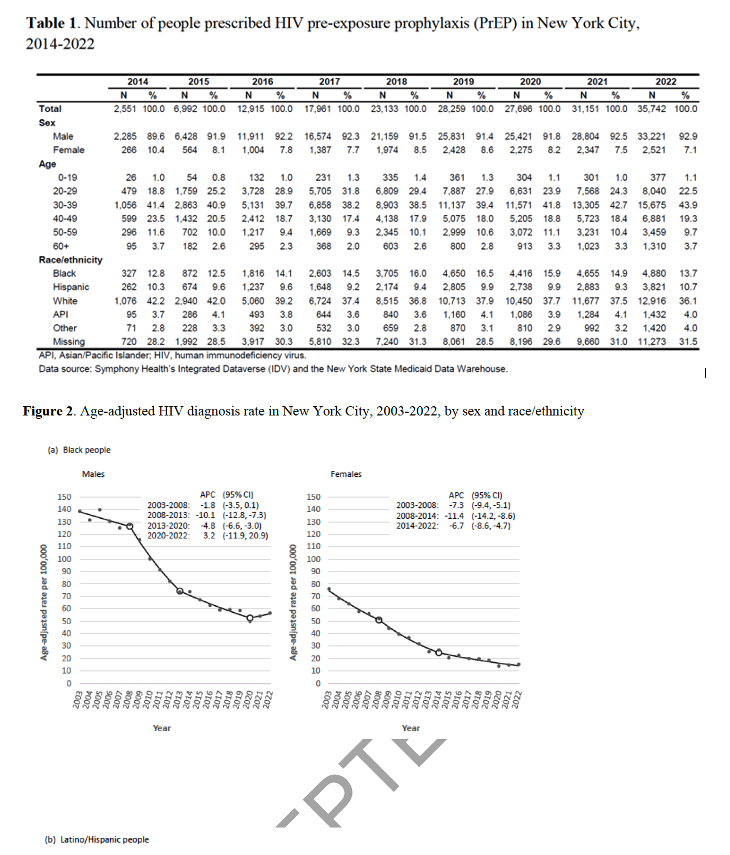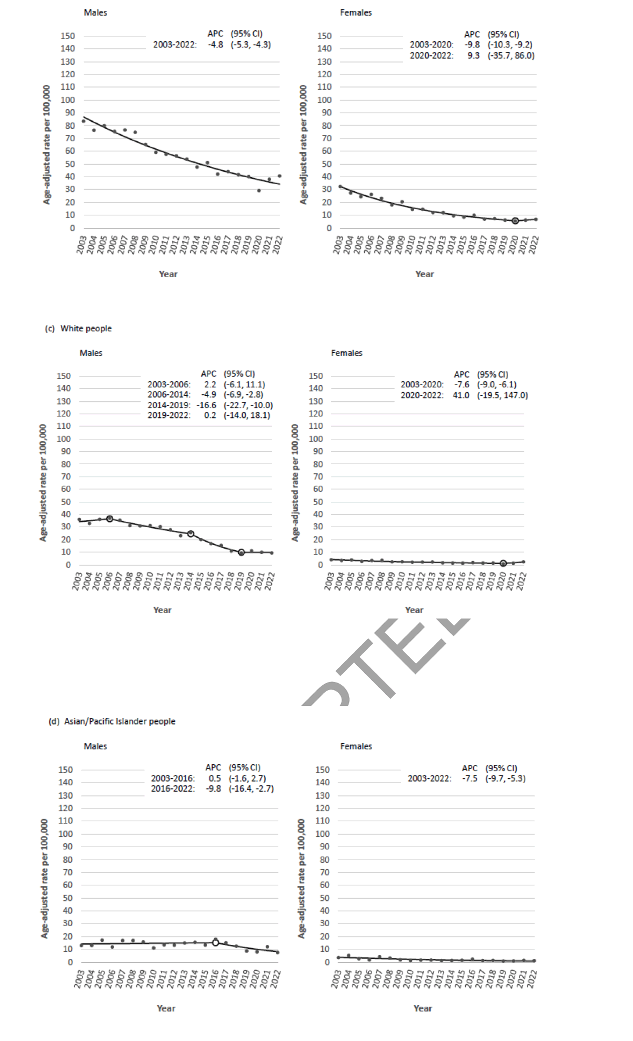| |
Impact of HIV pre-exposure prophylaxis prescriptions on HIV diagnoses in New York city: disparities in new HIV diagnosis
|
| |
| |
Download the PDF
Download the PDF
Xia, Qianga; Edelstein, Zoe R.a; Katz, Benjaminb; Bertolino, Daniela; Berry, Amandab; Tsoi, Benjamin W.a; Torian, Lucia V.a
May 14 2024
Results
The number of people filling at least one PrEP prescription in NYC increased from 2,551 in 2014 to 35,742 in 2022. PrEP prescriptions increased among all groups when measured by sex, age, and race or ethnicity (Table 1).
Our ecological analysis showed that PrEP accelerated the annual decrease in HIV diagnoses in some populations in NYC, but not overall.
The overall age-adjusted HIV diagnosis rate decreased from 48.1 per 100,000 in 2003 to 17.1 per 100,000 in 2022 (Figure 1), with an accelerated decrease starting before the rollout of PrEP (2007-2020 APC: -7.3%; 95% confidence interval [CI]: -7.7, -7.0). The rate among males decreased from 68.0 to 28.3 per 100,000, with an accelerated decrease starting before the rollout of PrEP (2007-2020 APC: -6.6%), and among females, the rate decreased from 30.1 to 6.4 per 100,000, with no accelerated decreases.
We found decreases across all groups when we measured the age-adjusted HIV diagnosis rate by sex and race or ethnicity, but accelerated decreases were only detected among white (2014-2019 APC: - 16.6%) and Asian Pacific Islander males (2016-2022 APC: -9.8%) after the rollout of PrEP (Figure 2).
We also found decreases across all groups when we measured age-specific HIV diagnosis rates by sex and age, but accelerated decreases were only detected among males aged 20 to 29 years (2017- 2020 APC: -9.4%) and 40 to 49 years (2014-2020 APC: -12.2%) after the rollout of PrEP (Figure 3).
By race or ethnicity and age, accelerated decreases were detected among Latino/Hispanic people aged 40 to 49 years (2015-2020 APC: -13.0%), white people aged 20 to 29 years (2012-2022 APC: -11.4%) and 40 to 49 years (2014-2018 APC: -27.8%), and Asian/Pacific Islander people aged 20 to 29 years (2017-2022 APC: -13.0) after the rollout of PrEP (Supplemental Figure 1,
http://links.lww.com/QAD/D214).
we conducted an analysis restricting diagnoses to those aged 20 to 29 years, who were more likely to be recently infected, and found an association of PrEP prescription with accelerated decrease in HIV diagnoses in Asian/Pacific Islander and white males but not in other groups.
Among people aged 20 to 29 years, an accelerated decrease was detected among white males (2012- 2022 APC: -11.8%) (Figure 4). The annual HIV diagnosis rate among Asian/Pacific Islander males aged 20 to 29 years changed from an increase before the rollout of PrEP (2003-2016 APC: 6.7%) to a decrease afterwards (2016-2022 APC: -11.0%).
There was a large drop in HIV diagnosis rates across most of the groups in 2020 attributable to the emergence of COVID-19 in NYC; rates subsequently rebounded in 2021 and 2022.
We did not observe the same level of impact on HIV diagnoses in other populations during the analysis period. The most likely reason for this was that the number of people at increased risk of acquiring HIV who were prescribed PrEP within these subpopulations was not sufficiently high to achieve the coverage needed to generate an accelerated decrease in HIV diagnoses. Studies have shown that women and Black and Latino/Hispanic people are less likely to be prescribed PrEP.24-26 Generally, those who might most benefit from PrEP might not be prescribed or using PrEP due to a variety of factors including structural, economic, provider limitations and biases, and individual-level influences such as stigma and medical mistrust.


|
|
| |
| |
|
|
|